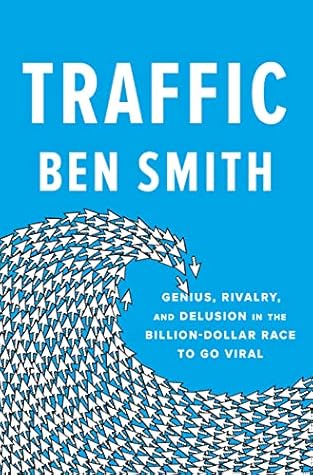More on this book
Kindle Notes & Highlights
by
Ben Smith
Read between
May 8 - May 23, 2023
Pretty soon Jonah was getting emails from newspaper reporters and, then, a booker for the biggest morning television program in America, the Today show.
traffic. But traffic, Jonah was among the first to discover, wasn’t merely mechanical. Traffic was human emotion, human psychology, desire and curiosity and humor.
He would note later that the internet was a far better outlet than graffiti for spreading a message, with “more impact and leverage with less legal risk!”
So Jonah went back to Cambridge to measure the same substance the hapless Nike spokesman had touted: traffic.
Cameron switched the focus of his research to something he called Blogdex, a new kind of measurement tool that could turn internet conversations into math—tracking, measuring, and mapping them.
that they needed to go not west, but south. The place to prove yourself in the nascent, experimental new media scene was downtown Manhattan.
of Nick’s offerings promised their audiences a faster, truer version of reality than you’d find in the tired and fusty mainstream media. Nick had spotted Cameron across
Tumblr. That technical trick drove Tumblr’s success, and was copied by other social networks—Facebook’s share, Twitter’s retweet. It would become the basic mechanism for a generation of amplifying everything from clever jokes to lies about elections.
during the first decade of the internet. The two junior partners would shape the decade to follow.
Yet both movements were rooted, in part, in the new way of thinking about people that came when you saw them as traffic—measuring interest and intent, and channeling it into action. So perhaps it’s not so surprising that Jonah Peretti and Andrew Breitbart worked out of the same office for a couple of months in 2005.
Nick and Drudge were the masters of something else: how to make a website “sticky.” They were masters of the refresh.
Take as a sample her spoof of New York magazine’s annual “Reasons to Love New York.” Jessica’s entries included “5. Because we get to push tourists if we’re late for work” and “57. Because everyone’s got a blog.” Jessica was the voice of an aggrieved creative underclass, raging against the pompous,
“Nobody ever searches for ‘Inequality in America.’
The Huffington Post’s media reporter broke the news, and Jonah got to watch through The Huffington Post office window with glee as angry Gawker executives gathered in their glassed-in Crosby Street headquarters.
Tracie Egan, who wasn’t posting as “Slut Machine” anymore but under her own name, wrote a piece for Vice about hiring a male prostitute to simulate “raping” her. Gavin
want the inside story, or to rip off his mask. They were there for cheerleading and affirmation, and The Huffington Post could give them that.
And people on Facebook didn’t want the truth: they wanted to be entertained. What could be less threatening, back then, than Facebook, where all anyone wanted to share was a few simple steps to get you through a rough day?
“He needs the next story like an addict needs their next fix,” Nick once said. AJ had described himself and the other editors as “puppies that have been trained to bite—even people who came into the house.”
But there was no looking back. Four months later, Disney announced it would buy Maker Studios, which helped YouTube stars like the gamer PewDiePie sell advertising, for roughly the same $500 million it had considered spending on BuzzFeed.
And the charts of traffic and revenue pointed ever upward. Mark Zuckerberg, legendarily, had turned down a $1 billion offer from Yahoo! in 2006, defying many of his advisers. Jonah could now go and tell his Disney story to the same people, show off his traffic, take their money, and keep growing.
The Internet’s Greatest Day,” BuzzFeed’s Charlie Warzel called it, and perhaps also the last good day on the internet,
The story outing a cheating, closeted husband was “solidly in line with what Gawker has asked its writers and editors to do for years,” a top editor wrote. That was true. But the internet was changing, and Nick was trying—and failing—to persuade his ragged band to keep up.
But he’d had to sell his beloved loft, and many of the people who had known Nick over the years began to wonder where he’d gone. He hadn’t moved on to his next thing, or to anything. He’d mostly avoided interviews. And, physically, he’d vanished.
What that meant for BuzzFeed, which had followed Facebook to this precipice, was “pressure to make bad content or underperform.”
from the Bronx, Alexandria Ocasio-Cortez—“a perfect foil,” he said. He loved the new world we’d helped create.
He’d played different roles on the internet: the trickster, the boy genius, the founder. He knew how to shape his image, and he enjoyed how people saw him. Now he was just management, a suit—and an incompetent suit at that.
To keep the illusion alive, an Ozy executive impersonated the YouTube employee on the conference call. But one of the Goldman bankers caught on to the scam, quietly killing the deal, and alerting YouTube to the deception. YouTube, in turn, called the FBI.
That willingness to do whatever it took to go viral was the quality we were looking for at BuzzFeed in 2015.


